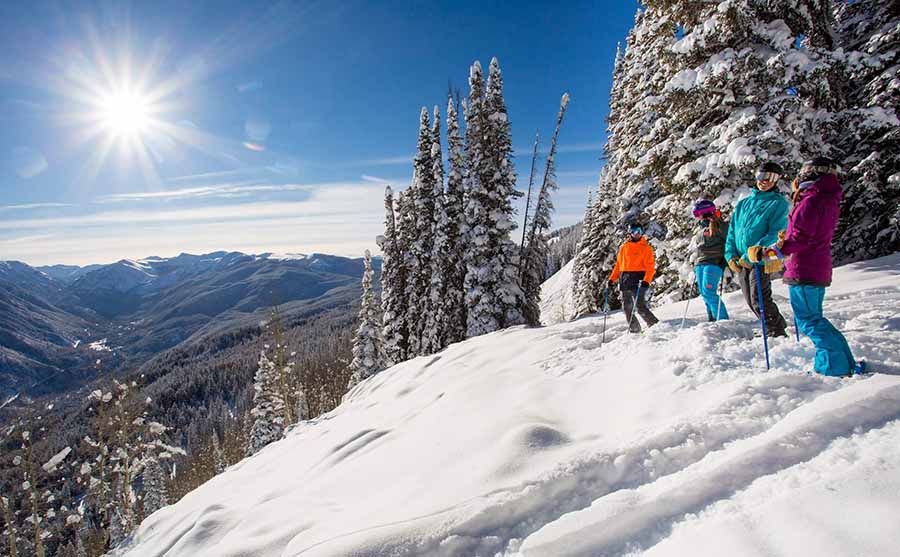Timely snow at many western mountain destinations helped nudge aggregated occupancy figures into positive territory after several months of decline while rate and revenues remained steady, according to DestiMetrics.
The most recent aggregated data from nearly 300 lodging properties throughout six western states from DestiMetrics’ monthly Market Briefing from Inntopia includes figures through February 29.
The Briefing emphasized that while the first three weeks of the month were pacing in a business-as-usual format, things began to change dramatically on February 24 with the plunge in domestic and global financial markets.
…
Occupancy for the month of February was up a slight 0.9 percent compared to last February and marked the first winter month this season to finish with an increase in occupancy. Meanwhile, the Average Daily Rate (ADR) was up a moderate four percent enabling revenues to move up to five percent in a year-over-year comparison to last February.
A view of the full winter season as of February 29 shows only modest changes during the month. Winter seasonal occupancy measured from November through April also moved into positive territory this month and is now up a minuscule .03 percent compared to last year at this time. Aggregated ADR for the season is up three percent with gains in every winter month except March, which is down a scant 0.1 percent. Seasonal revenues are also up three percent.
“Very strong, positive market conditions in the first three weeks of the month, and significant snow, particularly in the Rockies, allowed destinations to capitalize on rate strength,” said Tom Foley, senior vice president for business operations and analytics for Inntopia. “However, as everyone is well aware, the dramatic financial downturn in the final days of February due to the market consequences of the rapid global spread of the Covid-19 virus will have an impact on destination travel,” he continued. “At this point, it is too early to determine how significant and long-lasting that impact will be, although we’re seeing widespread changes to booking patterns for arrivals more than 90-plus days out.”
…
The booking pace during February was somewhat mixed. Bookings made for arrivals in the last three months of the ski season—February, March, and April—were all up significantly while the opposite was true for summer months. As of February 29, bookings made for arrivals in May, June and July are all down compared to the same time last year. This decline in booking pace is evidenced by the data as having begun in the last half of the month following previously positive pacing for those months and aligns with the downturn on financial markets that began on February 24. Overall, occupancy for the six summer months from May through October is flat compared to last year at this time, while ADR and revenues are up 2.6 percent.
A robust and relatively stable economy persisted through most of the month of February until the final days of the month when the Dow Jones Industrial Average (DJIA) plunged 11.9 percent and finished the month two percent below where it was in February 2019. In the last few days of the month, investors reacted strongly to the impact of the Covid-19 virus that has disrupted the supply chain from China for the past eight weeks and counting. There has also been a reduction in the demand for crude oil that is leading to a downward spiral on fuel prices around the world. As a result, corporations are revising their first-quarter expectations based on their inability to get vital materials for producing and distributing consumer goods to their national and international markets.
Escalating the woes of Wall Street is the cancellation of flights to and from Asia and the widely-reported difficulties to the recreational cruising industry. The spread of Covid-19 beyond Asia has put additional pressure on global travel and trade.
“As our data shows from past events, dramatic decreases in financial markets can have the effect of shocking consumers into a temporary spending freeze, but sustained, striking declines have the potential to foster significant consumer withdrawal from the entire marketplace including travel,” cautioned Foley. “But past data also shows that the mountain travel industry has been able to consistently rely on passionate consumers to sometimes behave in defiance of market forces. Whether or not these unique conditions, that also include Covid-19 fear, can foster that same defiance in the months ahead will not be clear in the data until the very dynamic conditions settle down in the upcoming weeks.” In reviewing other indicators through February 29, the Briefing emphasized that the positive direction of the Consumer Confidence Index (CCI) was assessed prior to the end of the month of the drop in the financial markets while the unemployment data covers the entire month.
The CCI, during February, edged up 0.2 percent and marked the fourth consecutive monthly increase in confidence. The national Unemployment Rate dropped from 3.6 to 3.5 percent in February as employers dramatically increased expectations by adding 273,000 new jobs to the payroll—well ahead of the 175,000 expected. Additionally, job creation figures in December and January were adjusted upward to create a three-month average of 243,00 new jobs per month for the three months. However, year-over-year wage earnings slipped down driven by a shorter than expected workweek.
“As we move through the final two months of the Winter 2019/20 season, our operating environment is dramatically different than it was as recently as two weeks ago,” added Foley. “We are obviously moving into a challenging phase for the travel and tourism industry as a whole, but mountain destinations may have an ace up their sleeve with their dedicated customer base. Whether or not that proves to be so, we are encouraging properties to be proactive in monitoring their data closely, working together as a community and industry and considering alternatives to rate cuts like value-added propositions, all the while being empathetic to their guests who are also trying to navigate these unique times,” Foley concluded.
Photo courtesy Colorado Ski Country USA
















